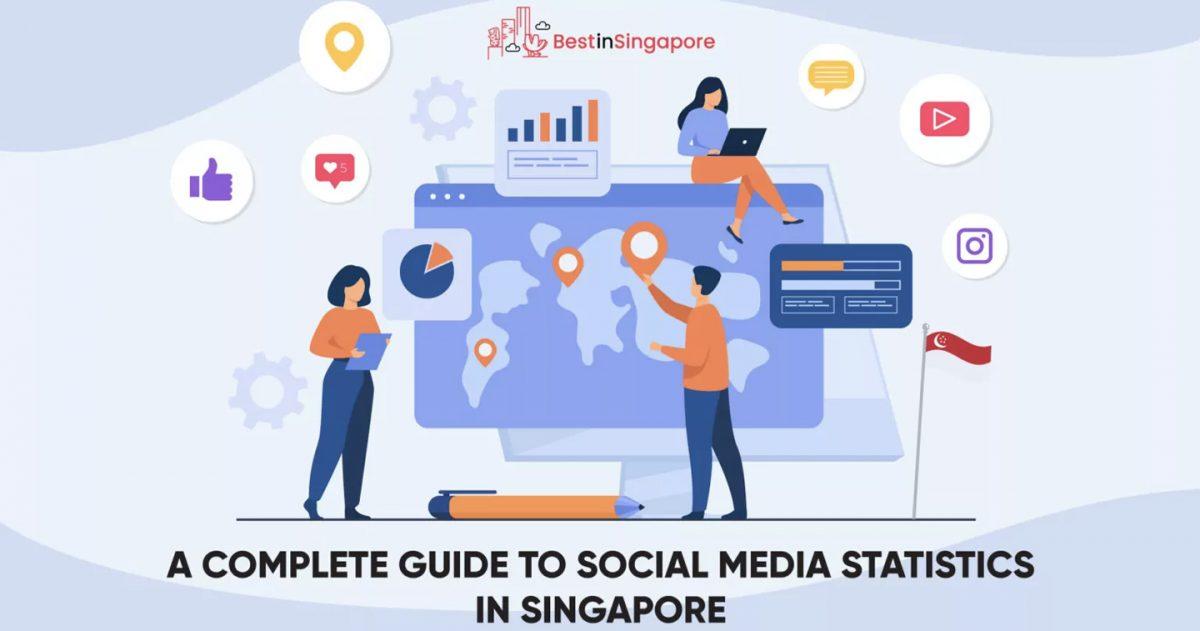SINGAPORE — According to Global Finance, Singapore is the 11th most technologically advanced country in the world. With blistering connection speeds and top-class penetration rates, it’s easy to see why.
These conditions create the perfect environment for social media use in Singapore to rapidly flourish. As an example, from 2017 to 2021 alone, the number of social media users in Singapore saw an 11.2% increase. This translates to 4.96 million social media users as of January 2021.
At the beginning of 2023, Singapore had 5.81 million internet users, with 5.08 million social media users, which corresponds to 84.7% of the population. To put things into perspective, here are notable Singapore social media insights in 2023.
Most popular social media platforms in Singapore
In Singapore, social media usage reflects a mature internet infrastructure and high digital literacy. WhatsApp is the most dominant platform, used by approximately 83.7% to 98% of internet users. Facebook and Instagram also have significant engagement, with 65-80% of users actively participating. Telegram’s growth is notable, particularly among users concerned about privacy on Facebook-owned platforms.
The social media landscape is also characterized by a strong trend in social commerce, with Facebook leading in livestreaming sales. Livestreaming, combined with short-form video content, is reshaping the way brands engage with consumers. Meanwhile, TikTok, known for its 15-second videos, is influencing advertising strategies with its short, engaging content format.
As of 2022, about 4.9 million active social media users are in Singapore, making up 89.5% of the addressable demographics. The data highlights a diverse social media ecosystem adapting to changing consumer preferences and technological advancements.

Singapore’s social media habits
With a population highly connected digitally, Singaporeans spend an average of two hours and 13 minutes per day on social media. It accounts for 84.7% of the total population actively using an average of 7.1 social media platforms. This was also a slight increase in social media usage in Singapore in 2021, where most Singaporeans spend about two hours every day on one social media platform or another.
Social media in Singapore serves various purposes, including communication, entertainment, education, and commerce. The trend of social commerce is particularly notable, with platforms like Instagram becoming significant channels for ecommerce activities. This further emphasizes the importance of social media in marketing.
In addition, Singaporeans often use social media as a convenient way to stay in touch with distant family and friends. This is particularly useful for those immersed in their careers, offering an opportunity to maintain personal connections and boost morale. About 45.9% of users engage in this manner. Additionally, platforms like YouTube and TikTok are popular for entertainment, with 36.7% of users watching short videos, listening to music, and following favorite personalities, especially during commutes or to unwind after work.
Other drivers of social media use in Singapore are:
- maintaining contact with family and friends
- utilizing time during leisure moments
- keeping up with news articles
- following trending topics
- discovering engaging content
- seeking activities or items for purchase
- finding products to buy
- exploring content from various brands
- participating in live streaming events
- preventing the feeling of missing out
- sharing updates about personal life
- following celebrities and influencers
- engaging in work-related activities
- connecting with people who share similar interests
- sharing personal viewpoints and opinions
When it comes to social media access by devices, Singapore recorded 9.22 million cellular mobile connections, a notable rise of 574,000 from 2022. This number exceeds the total population, partly because many individuals use multiple connections for personal or work reasons.
In 2022, 72.8% accessed social media solely through their mobile phones. This year, it grew to 89.5%. The shift towards mobile is propelled by the advanced capabilities and intricate nature of modern smartphones. This has resulted in a significant increase in the amount of time spent on mobile apps, as well as the convenience that mobile phones offer in terms of accessing social media.

Social media users by age
Meta products, including Facebook, Instagram, and Facebook Messenger, are the most popular social media among the 25-44 age group in Singapore. The 25-34 year olds form 35.8% of Meta’s ad audience, with the 35-44 age group at 23.3%. The age groups are made up of people who were in their teenage or adolescent years during the rise of Facebook. As a result, they are the users who are most familiar with the classic social media platform.
Singapore’s younger age demographic, particularly ages 16-34, belongs largely to alternative platforms such as YouTube and TikTok. These two platforms stand out from the crowd because they are mainly video-based. TikTok’s user demographics, while not specifically detailed for Singapore, are expected to mirror trends seen in the US, where 41% of users are 16-24 years old.
Instagram is also popular with younger audiences, with around 85% of users aged 16-24. On the other hand, WhatsApp usage is highest among Baby Boomers and slightly lower among Gen Xers.
With its unrivaled reach, connective capabilities, and daily use, social media has become a true part of modern life. But, unexpectedly as a result of this integration, these platforms have also created modern dilemmas.
Social media abuse in Singapore
When people share their personal information on a wide and unfiltered level, the opportunity for misuse arises. On many social media sites like Facebook, users are experiencing virtual harassment known as cyberbullying.
Cyberbullying
Unfortunately, cyberbullying often occurs among younger Singaporeans who lack the knowledge to deal with these occurrences. In recent Singapore social media statistics, about 23% of Singaporeans, including 27% of those under 25, use fake or alternative social media profiles for anonymity. Research indicates that the highest incidence of cyberbullying among young people occurs on YouTube (79%), followed by Snapchat (69%), TikTok (64%), and Facebook (49%).
The majority of victims developed depression or a form of social anxiety. In a way, the unregulated use of social media has ironically resulted in users shrinking away from social interactions altogether.
These experiences will only escalate as the number of social media users rises in the future. To properly address this growing issue, users should be educated on the effects of cyberbullying as well as the steps to avoid it.

Cyber Scams
Aside from harassment, social media usage in Singapore has resulted in a growing number of cyber scams staged from various social media platforms. Most of these scams occurred on Instagram and Facebook through identity theft and impersonation.
In 2019 these scams were relatively rare with only 83 reported cases, but in the first half of 2020 alone, the number rose to a whopping 1,175 cases.
In the first half of 2022, Singapore reported a loss of at least $227.8 million due to scams, with 971 cases of social media impersonation, slightly higher than the previous year. The largest loss in a single case reached $243,000. Additionally, “love scams” have become prevalent, with 477 cases in early 2022, a significant rise from 62 cases in 2011.
A big contributor to the rise in scams is believed to be the isolation, uncertainty, and fear caused by the Covid-19 pandemic.
Be it cyberbullying or cyber scams, a user’s main defense against social media abuse in Singapore will always be education. Older users will greatly benefit from learning how to identify possible scammers on social media platforms.
On the other hand, younger users will be much more prepared by learning about cyberbullying as well as how to deal with such occurrences. With more informed social media usage, Singapore may see a reduction in social media abuse as a whole.
Ultimately, though some dangers exist side by side with it, social media presents a unique and revolutionary way for Singaporeans to communicate with each other and the world at large.
These platforms have truly shaped the way people think, act, and live in the 21st century. Used properly, social media may help the island nation develop far into the future.

What the Philippines can learn from Singapore’s social media usage
The Philippines can gain valuable insights from Singapore’s social media scene, particularly in how brands leverage social media platforms. Singapore’s most popular social media platforms, including WhatsApp, Facebook, Instagram, and TikTok, offer diverse avenues for brands to engage with their audiences.
Understanding social media use in Singapore reveals a trend towards integrating communication, entertainment, and commerce. Brands effectively use these platforms for targeted advertising, customer engagement, and creating a seamless shopping experience. And by observing and adapting these strategies, the Philippines can enhance its social media utilization for brand growth and audience engagement.
Singapore’s social media use in the years to come
As Singapore continues to rank high in technological advancement, its social media landscape is expected to keep evolving.
The future will likely see brands further utilizing platforms like WhatsApp, Facebook, Instagram, and TikTok not only for basic communication but also for more integrated marketing strategies. These platforms, already popular for their entertainment value, will increasingly play a crucial role in social commerce, blending consumer interaction with seamless shopping experiences. However, with this growth, Singapore must also address rising challenges like cyberbullying and cyber scams. The evolving social media usage in Singapore offers valuable lessons for other countries in enhancing brand engagement and combining various elements for business and community growth.








